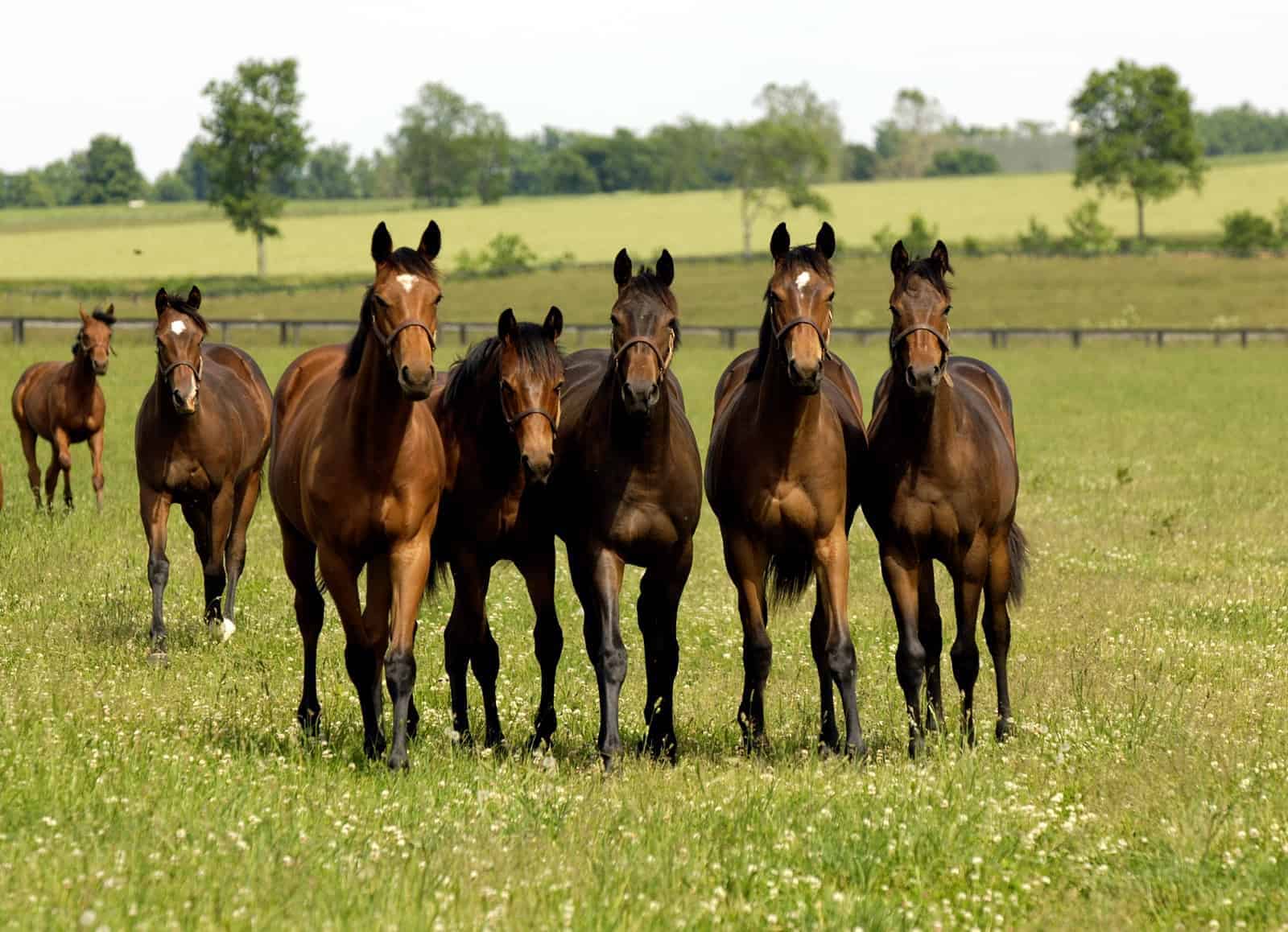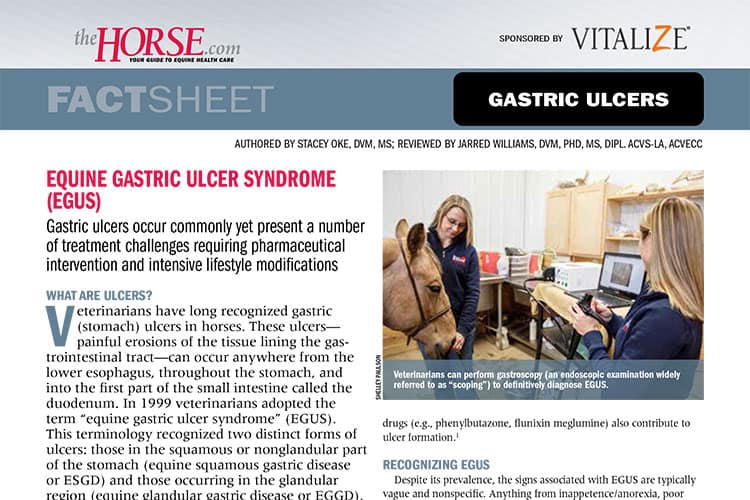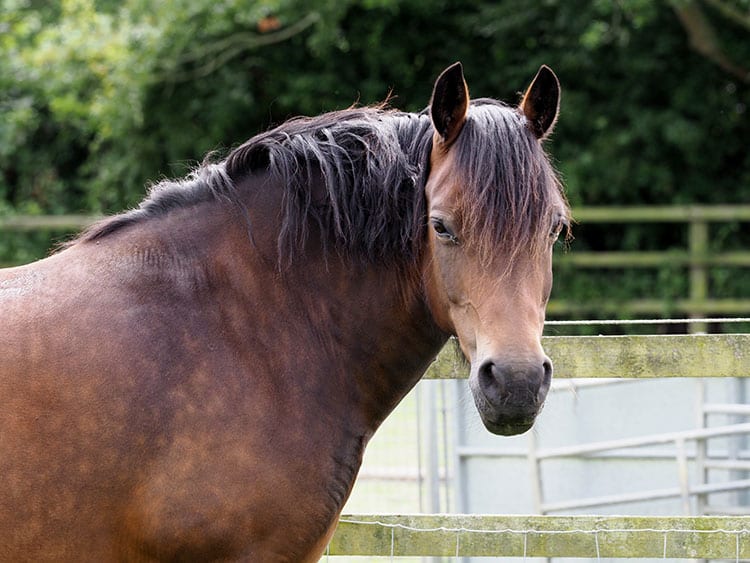Using Diet to Deter Equine Diseases

Proper nutrition can improve your horse’s musculoskeletal, immune, endocrine, and gastrointestinal health
The age-old adage, “Let thy food be thy medicine,” often ascribed to Hippocrates, regularly comes up in health and wellness circles. Hippocrates likely aimed his advice at humans but, given the links between horses and humans in many research trials, it seems fair that we could bring this wisdom to feeding our horses, too.
The unique combination of your horse’s age, genetics, and lifestyle might predispose him to specific health problems. The good news is the best treatment could be as simple as providing the correct nutrition to optimize his musculoskeletal, immune, endocrine, and gastrointestinal systems.
Growing Horses: Focus on Joint Health
“They grow up so fast!” applies as much to the young, growing horse as it does to a child. Foals become yearlings before you know it, and their body systems develop and change more rapidly than they will at any other point in life. All the while, it is crucial that their musculoskeletal systems do not change too quickly.
Developmental orthopedic disease (DOD) is an umbrella term used to describe the laundry list of growth-related conditions that can affect a young horse’s developing musculoskeletal system: osteochondrosis, osteochondritis dissecans, physitis, angular and flexural limb deformities, flexor tendon disorders (club feet, contracted tendons), and cervical stenotic myelopathy (wobbler syndrome).
Common signs DODs share include joint pain and swelling, increased time spent lying down, stiffness, suboptimal conformation, and “knuckling” joints.
While veterinarians treat each condition a little differently, it is well-established that three things can cause DODs: genetics, nutrition, and exercise.
Ideally, before you breed a mare you’ve taken her genetics and conformation (as well as the stallion’s) into account. Once the foal is on the ground, you can’t do much to alter his genetics, but you can up- or downregulate how those genes express themselves through proper nutrition.
“Careful nutritional management in a horse with genetic susceptibility to DODs can stave off its progression,” says Amanda Bradbery, MS, PhD, equine nutritionist and assistant professor of equine science at Montana State University, in Bozeman, referring to fast-growing breeds such as Thoroughbreds. “However, poor nutritional management will exacerbate the genetic predisposition to DODs and the need for expensive veterinary intervention.”
Nutrition is arguably the most important component in preventing DODs from occurring in growing horses. “Maintaining a steady plane of growth is imperative,” says Bradbery. “Rate of growth should steadily decrease as a foal matures. Irregularity in growth plane caused by periods of slow growth followed by periods of rapid growth often results in greater incidences and severity of DOD.”
Overfeeding foals—in other words, “too many calories too fast”—can place too much stress on the underdeveloped joints and skeletal system. On the other hand, underfeeding for a period, followed by an increase in nutrition, can result in growth compensation, or rapid growth, to catch up. This can be equally detrimental to musculoskeletal development.
“It’s all about balance and finding the appropriate nutritional plan to support a steady plane of growth,” says Bradbery.
Micronutrients such as minerals and vitamins, while making up a small percentage of the diet, also play a large part in the growing horse’s healthy development.
“Calcium, phosphorus, copper, and zinc all play roles in the development of bone and soft tissue,” says Jessica Leatherwood, MS, PhD, equine nutritionist and assistant professor of animal science at Texas A&M University, in College Station. “Any disruptions in dietary concentrations of minerals, both deficient and excessive, may increase risk of DOD.”
Choose a feed designed specifically for foals that has been formulated by an equine nutritionist, and refer to the feed tag for the appropriate feeding rates. Also be sure he has access to good-quality forage. If your foal is particularly at risk for DODs based on his breed, it might be prudent to feed an equine ration balancer to provide him appropriate nutrition but minimal calories.
When it comes to exercise, both minimal and excessive amounts can negatively affect development. Allow your foal as much pasture turnout and time to play as possible, which will naturally optimize the amount of time his limbs and joints spend weight-bearing. Avoid intense forced exercise in tight circles for extended periods, which weights joint surfaces unequally.
Overall, make sure you involve your nutritionist and veterinarian during the growing stages, as they can help set your horse up for a long and healthy life.
Leatherwood sums it up: “Sound growth can be achieved by utilizing balanced diets that support steady growth while maintaining young horses in moderate body condition.”

Performance Horses: Alleviate Stress
Once your horse is under saddle, he faces new threats. Performance horses are subject to all kinds of physical and mental stresses. Equine athletes face frequent travel, moderate to intense training, and often increased time in stalls. And while many of these horses enjoy their jobs, their modern lifestyles are still very removed from the way wild horses evolved, leaving them susceptible to disease.
Equine gastric ulcer syndrome
The American Association of Equine Practitioners estimates that at least 60% of performance horses and 90% of racehorses are affected by gastric ulcers.
The anatomy of the equine stomach and the ways we manage horses in the modern world are key to understanding why gastric ulcers are so prevalent.
“Natural horse diets are characterized by continuous grazing, which involves consumption of a high-fiber, low-starch diet, with adequate voluntary activity,” says Leatherwood. “Metabolically, this natural diet centers on a low glycemic index (little fluctuations in blood glucose/insulin) and a stable hindgut environment (a neutral pH, stable microbial population in the portion of the digestive tract beyond the small intestine).”
Because horses evolved to graze all day, their stomach produces acid continuously. When the horse has feed in his stomach, the acid has something to “eat,” for lack of a better word, but if the horse is stressed and living with an empty stomach for long periods (as is the case when he is only being fed meals two to three times per day), issues arise, and ulcers can develop quickly, sometimes within five to seven days.
Typical management methods involve providing supplemental grain concentrate meals, which drive greater fluctuations in blood glucose and insulin, says Leatherwood. “This impacts the hindgut by decreasing pH and ultimately changes the microbial populations.”
But let’s back up to the horse’s stomach for a moment. It is divided into two sections: nonglandular and glandular. The glandular region is the area that produces hydrochloric (HCl) acid, pepsin (the chief digestive enzyme in the stomach, which breaks down proteins into polypeptides), bicarbonate, and mucus. Bicarbonate and mucus act as protection; they help safeguard the glandular region from the highly acidic environment, though glandular ulcers still can occur. The nonglandular region, on the other hand, does not produce a buffer and lacks the thick, protective mucus layer, making it more vulnerable to the acid.

When horses exercise (often on an empty stomach), the ulcer issue is compounded by the fact that acid splashes up from the glandular region to the nonglandular region as the stomach contracts during exercise, leading to even more damage and, soon, a dangerous cycle of events.
Additionally, administration of non-steroidal anti-inflammatory drugs (NSAIDs), such as Bute or Banamine, for prolonged periods can decrease buffer production. In fact, “daily administration of NSAIDs for as little as three to nine days can result in the development of gastric ulcers by modifying normal metabolic pathways,” says Bradbery.
If your veterinarian suspects your horse has ulcers, he or she will use endoscopy to make a diagnosis. Typically, vets prescribe medications such as omeprazole (UlcerGard and GastroGard) to help prevent and heal ulcers, but real long-term prevention requires diet and management interventions. The No. 1 thing you can do to prevent gastric ulcers in your performance horse is to reduce stress. This means increasing your horse’s total turnout time, ensuring he has adequate social interaction, and, perhaps most critically, allowing him free-choice access to hay or grass.
Research has shown that especially vulnerable highly stressed performance horses might benefit from being fed small amounts of alfalfa hay prior to training. Alfalfa naturally contains a buffer, which might coat the stomach and help protect it from acid splash during exercise.
Tying-up and PSSM
If you own or ride performance horses, you’ve probably heard about or seen tying-up, a condition in which muscles spasm and cramp, causing the horse to sweat excessively and refuse to move and ultimately leading to muscle damage.
Some horses occasionally show signs of tying-up, while others face chronic episodes. Acute episodes are typically linked to overtraining, electrolyte imbalance, or a vitamin E and selenium deficiency. Researchers believe several conditions cause chronic tying-up: recurrent exertional rhabdomyolysis (RER), malignant hyperthermia (MH), and polysaccharide storage myopathy (PSSM).

MH is a genetic skeletal muscle abnormality in Quarter Horses and Paints, and RER occurs when the muscles don’t contract properly. PSSM is a hereditary problem in which a defect in the muscle cells causes them to store excessive amounts of carbohydrate and glycogen.
While treatment plans for affected horses vary, general recommendations revolve around nutrition and exercise.
It is important to keep animals that are prone to tying-up in a regular exercise program, either with daily training or turnout. High-starch diets can cause episodes, so have your hay tested to be sure it’s low in sugar (and soak it if it isn’t, being sure to discard soak water), and supplement with fat sources for added calories and a ration balancer for vitamins and minerals.
These horses might also need supplemental vitamin E and selenium. Because selenium content in forages varies by geographic region and consuming excessive amounts can be fatal for horses, it is imperative to work with an equine nutritionist and veterinarian to ensure that your horse’s diet is meeting and not exceeding his requirements for this mineral.

Adult Maintenance Horses: Beware of ‘Too Much’
It’s easy to overfeed the adult horse at maintenance or the easy keeper; we love them, and they can drive a hard bargain with pleading eyes at mealtime. While it might feel right to indulge their hearty appetites, we’re doing them more harm than good.
Equine metabolic syndrome (EMS)
This endocrine disorder is associated with three common signs: insulin resistance, obesity, and laminitis. While it’s important to rule out other conditions, such as pituitary pars intermedia dysfunction (PPID, formerly known as equine Cushing’s), these three conditions in combination strongly point to EMS.
Leatherwood describes EMS as “failure of normal insulin concentrations to induce a response in target tissues, the liver, adipose, and skeletal muscle. EMS impacts vascular function that drives nutrient delivery to tissue.”
Many EMS horses have regional fat deposits and a cresty neck. They also have elevated blood insulin levels (hyperinsulinemia), due to increased insulin secretion or delayed clearance. But because insulin is ultimately successful in getting glucose delivered, blood glucose levels are typically normal. Hyperinsulinemia can trigger laminitis—a painful condition affecting hoof laminae—in these horses, often after abrupt diet changes or when they consume too many starches and sugars.
The good news about EMS is it’s 100% manageable through diet. Managing a horse’s weight is arguably the most important component of prevention and treatment, especially in breeds predisposed to EMS due to a “thrifty gene” that makes them more feed-efficient.
“Horses with EMS can easily be managed with a low-starch diet,” says Bradbery. “Most often this is through a hay-only diet; however, there are more commercial low-starch feeds available today than ever before. The goal is to prevent any spike in blood glucose levels since the underlying cause of EMS is glucose and insulin dysregulation.”
Leatherwood agrees that “careful selection of hay and grain is critical. A ration balancer pellet is desirable due to the lower sugar and starch levels and is complementary to a high-quality forage source. Furthermore, always follow manufacturer’s recommendations for feeding rate. When it comes to hay, I always encourage testing and selection of hay with less than 10% nonstructural carbohydrates.”
Work closely with your veterinarian and nutritionist to devise the best plan for your EMS horse. In general, avoid turning an affected animal out on early season lush pasture; it can lead to uncontrolled intake, and the high starch and sugar levels can trigger a laminitis episode.
Leatherwood suggests keeping detailed feeding records of “products, weights, amounts, and frequency,” so you can track any changes in your at-risk horse.
Pituitary pars intermedia dysfunction
Researchers estimate that PPID affects more than half of the senior horse population, defined as horses over age 15. A dysfunction in the intermediate lobe of the equine pituitary gland, which regulates the production of many hormones in the body, causes it.
Ultimately, PPID leads to overproduction of glucocorticoid or stress hormones. One telltale sign is a long hair coat that the horse does not easily shed, but the disease can also reduce immune function, increase laminitis risk, and sometimes distribute odd deposits of fat across the body.
While age is the primary risk factor for PPID, high-grain diets fed to obese or inactive horses can also put younger horses at risk.
If you suspect your horse has PPID, have your veterinarian confirm it with diagnostic testing. If the results are positive, he or she will likely prescribe medication and strict management practices. Have your hay tested regularly, and feed a diet similar to that of an EMS horse. Your veterinarian and nutritionist can help you manage your senior horse with great care.
Take-Home Message
All things considered, adapting your horse’s nutrition plan to his current stage of life, training schedule, and genetics is the best plan for preventing health problems. Be proactive, and involve professionals early on.
And remember, when making any diet changes, do so slowly, incorporating new feedstuffs over a two-week period to avoid creating digestive distress.
Written by:
Emily Dickson, MS
Related Articles
Stay on top of the most recent Horse Health news with











